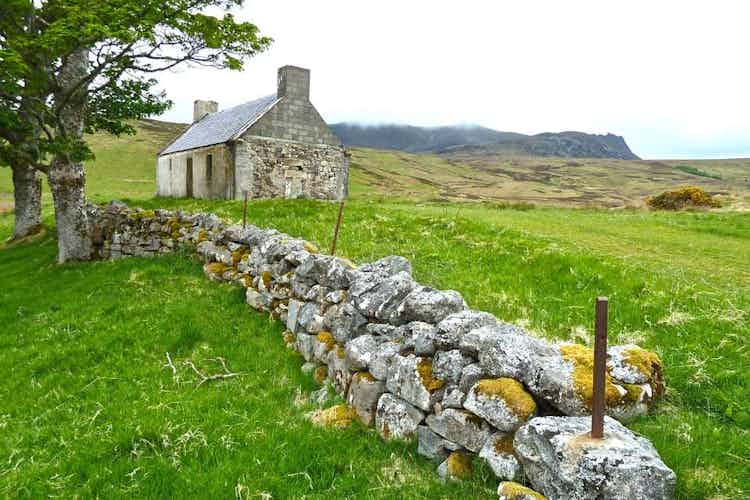In my previous article about buying a place in the country, I bemoaned what was and still is an overheated housing market. We intend to buy a place with land, start up a smallholding, and boost our income by doing some holiday rentals. While experiencing the frustrations of buying a place, we also got to learn some of the ins and outs of the process of gaining planning permission.
Full disclosure: I’m still pretty wet behind the ears when it comes to planning regulations. However, I do have a reasonable overview of how planning regulations can scupper the best-laid plans, so I can hopefully pass on a few bits of advice.
The planning process may seem about as Byzantian as the current Covid-19 regulations, but I'm grateful it is there to protect both the urban landscape and the countryside. Imagine giving celebs and the latest internet sensations a free hand. We’d be in Las Vegas.
Television programmes tend to dramatise the planning process for the sake of a good story, but most planning departments have duty officers you can speak to before committing to a property. A consultation will only cost a small amount, and you will get a good idea of the feasibility of your project. If your ‘Grand Design’ hinges on the outcome of a final council meeting, then you haven’t done enough homework.
Permitted Development
Permitted Development allows you to build without planning permission, and this works well if you’re planning an extension. You can build a single-storey extension of up to 6 metres, or 8 metres if your house is detached. This applies if the extension is at the back of the house. It mustn’t be taller than the existing house (double stories can only extend outwards for 3 meters. And side extensions cannot front the road.
Side extensions should be single-storey and can’t extend more than 3 metres. They should not be wider than half the width of the house. If you are thinking of something larger, you may be able to extend for up to 40% of the footprint of your property but you would need to apply to your local planning department.
If you are thinking of buying a listed building in an Area of Outstanding Natural Beauty or a National Park, permitted development doesn’t apply. These areas usually have a planning officer who can advise you on what is considered acceptable and what doesn't stand much chance. For more details, go to
https://designfor-me.com/project-types/extensions/how-big-can-i-build-an-extension-without-planning-permission/.
Adding buildings
If you want to add buildings to your property, then constructions like summer houses, garden rooms or sheds are generally okay, although there is usually a height restriction of 2.5 meters. You can put up buildings for poultry or to keep bees or build a sauna. This in on the condition that it is within curtilage* of your property (not in an adjoining paddock) and ‘for a purpose incidental to the enjoyment of the dwelling house.’
This means the building you erected added cannot be self-contained accommodation and cannot be occupied on a day-to-day basis unless you have planning permission. This is contrary to popular belief that you can build a granny annexe on your property without permission. The regulations state: ‘A purpose incidental to a house would not, however, cover normal residential uses, such as separate self-contained accommodation or the use of an outbuilding for primary living accommodation such as a bedroom, bathroom, or kitchen’.
Planning v building regulations
Even if your project falls within the permitted development category, you may need to have the finished work approved by building regs. Building regulations differ from planning as they give a set of standards intended to ensure people's health and safety for the design and construction of a building. Planning guides the way urban and rural building develops.
You will need work that included extensions, new services in a building for washing or sanitary purposes, hot water, drainage, replacement windows and fuel-burning appliances signed off by building regs. If builders are doing the work, it is their responsibility to get the work signed off. Ensure you confirm this before they start work because ultimately, you will get the enforcement notice should the completed work not comply.
Pastures, paddocks and woods
If you are considering buying a house with land, you’ll find that you are quite limited in what buildings you can put on it. Adjoining paddocks and fields will most likely be land designated for agricultural purposes. A field close by may seem an ideal place to put a cabin or build an annexe, but these enclosures are not considered as areas suitable for permitted development.
To put anything on agricultural land, other than small field shelters, you will need planning permission. If the land has been given equestrian use, then you can reasonably expect to be granted permission for stables. Likewise, a barn, a shed or workshop outside the curtilage of the property will need planning permission. Although as long as it is for keeping animals or machinery and within the specification set out, it should be granted. See https://www.gov.uk/planning-permissions-for-farms.
This would seriously affect your plans if you were considering making a living from holiday rentals because a building classified as self-contained accommodation (including mobile homes) changes the use of the land from agricultural to residential. It is possible to apply for a change of use of agricultural land, but in most cases, the chances of success would be low.
An extra income source
If you are thinking about putting a cabin, caravan, shepherd's hut, or yurt on your land, then (sorry!) the planning department will again need to be involved. It is a fair argument that this would provide an extra income source, which may mean your application is looked on more favourably. Often there will be conditions relating to the length of time you can rent visitors (usually around 40 weeks a year), and generally, stays are limited to a maximum of 6 weeks per client.
‘Fill it with tents!’
When I have discussed with friends and family how the labyrinth of planning rules works, they usually get bored halfway through and come up with the ‘default option’, ‘Just take a field and fill it with tents!’ As if to say ‘’Well, it’ll cause mayhem, but at least you'll earn some money’’. But good news! The 28-day rule (currently thanks to Covid-19, the 56-day rule) allows land to be used for camping under permitted development rights.
You can also put-up temporary structures such as toilets (and if you're going to have 30 people camping on your land, this is a particularly good idea) and showers or reception units, on the condition that the land is returned to its original condition afterwards. If you want more information on this, you can go to
https://www.pitchup.com/how-start-campsite-caravan-park/#PermittedDevelopment. You should also contact your local authority to find out if you will require a site licence.
Speak to the planners
Government planning rules can be interpreted differently from local authority to local authority and change year by year. As such, the best advice if you are thinking of buying a property is to have a chat with the duty planning officer for the area. This will cost you around £50, and you can usually do it over the phone.
If you are thinking about doing something with your existing property or land, you can arrange a pre-planning application visit where a planning officer will meet you on-site and let you know what is likely to be viewed favourably. Depending on your project, the cost is around £500 but in the end, it will probably be worth it, and you won't have to sweat over that final 'will they, won't they?' meeting.
* The open space situated within a common enclosure belonging to a dwelling-house. This includes the garden and driveways and should be shown in the deeds of the house.






